Mora: Enabling Generalist Video Generation via A Multi-Agent Framework
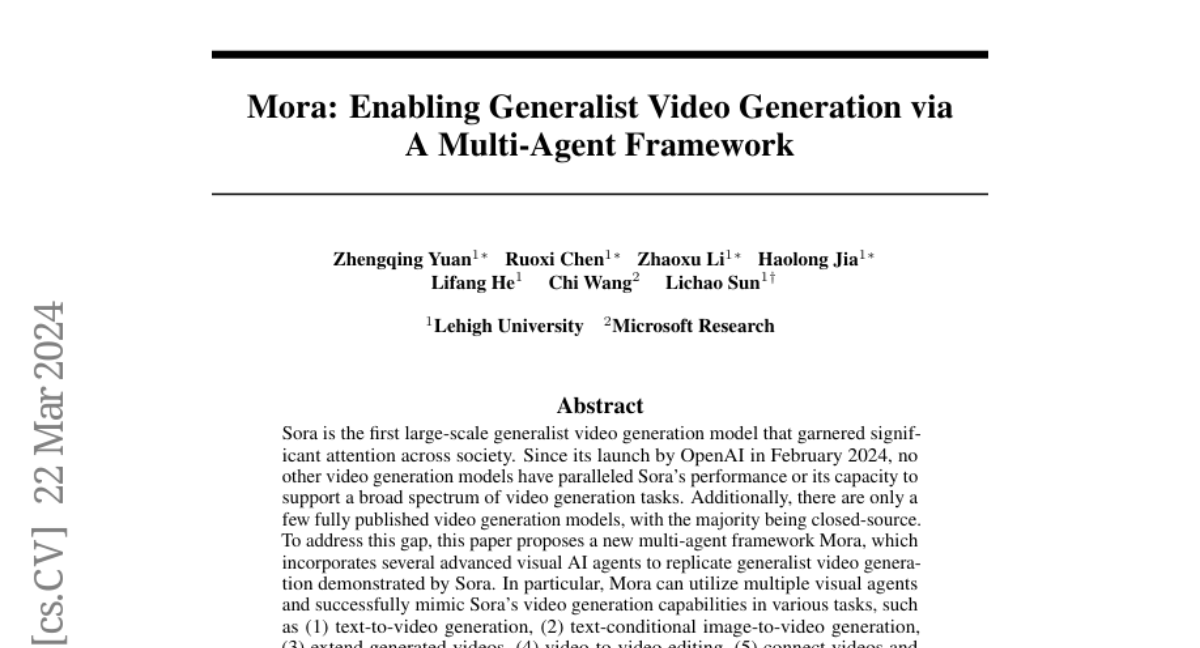
Sora is the first large-scale generalist video generation model that garnered significant attention across society. Since its launch by OpenAI in February 2024, no other video generation models have paralleled {Sora}'s performance or its capacity to support a broad spectrum of video generation tasks. Additionally, there are only a few fully published video generation models, with the majority being closed-source. To address this gap, this paper proposes a new multi-agent framework Mora, which incorporates several advanced visual AI agents to replicate generalist video generation demonstrated by Sora. In particular, Mora can utilize multiple visual agents and successfully mimic Sora's video generation capabilities in various tasks, such as (1) text-to-video generation, (2) text-conditional image-to-video generation, (3) extend generated videos, (4) video-to-video editing, (5) connect videos and (6) simulate digital worlds. Our extensive experimental results show that Mora achieves performance that is proximate to that of Sora in various tasks. However, there exists an obvious performance gap between our work and Sora when assessed holistically. In summary, we hope this project can guide the future trajectory of video generation through collaborative AI agents.
When Do We Not Need Larger Vision Models?

Scaling up the size of vision models has been the de facto standard to obtain more powerful visual representations. In this work, we discuss the point beyond which larger vision models are not necessary. First, we demonstrate the power of Scaling on Scales (S$^2$), whereby a pre-trained and frozen smaller vision model (e.g., ViT-B or ViT-L), run over multiple image scales, can outperform larger models (e.g., ViT-H or ViT-G) on classification, segmentation, depth estimation, Multimodal LLM (MLLM) benchmarks, and robotic manipulation. Notably, S$^2$ achieves state-of-the-art performance in detailed understanding of MLLM on the V* benchmark, surpassing models such as GPT-4V. We examine the conditions under which S$^2$ is a preferred scaling approach compared to scaling on model size. While larger models have the advantage of better generalization on hard examples, we show that features of larger vision models can be well approximated by those of multi-scale smaller models. This suggests most, if not all, of the representations learned by current large pre-trained models can also be obtained from multi-scale smaller models. Our results show that a multi-scale smaller model has comparable learning capacity to a larger model, and pre-training smaller models with S$^2$ can match or even exceed the advantage of larger models. We release a Python package that can apply S$^2$ on any vision model with one line of code: https://github.com/bfshi/scaling_on_scales.
Towards 3D Molecule-Text Interpretation in Language Models
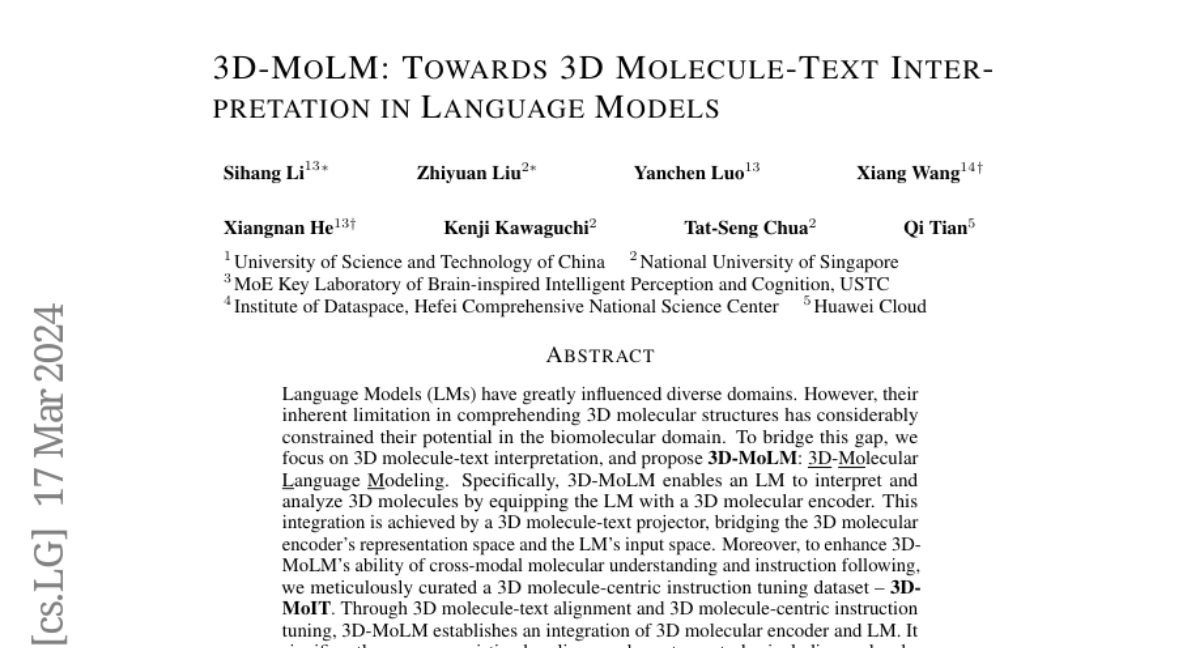
Language Models (LMs) have greatly influenced diverse domains. However, their inherent limitation in comprehending 3D molecular structures has considerably constrained their potential in the biomolecular domain. To bridge this gap, we focus on 3D molecule-text interpretation, and propose 3D-MoLM: 3D-Molecular Language Modeling. Specifically, 3D-MoLM enables an LM to interpret and analyze 3D molecules by equipping the LM with a 3D molecular encoder. This integration is achieved by a 3D molecule-text projector, bridging the 3D molecular encoder's representation space and the LM's input space. Moreover, to enhance 3D-MoLM's ability of cross-modal molecular understanding and instruction following, we meticulously curated a 3D molecule-centric instruction tuning dataset -- 3D-MoIT. Through 3D molecule-text alignment and 3D molecule-centric instruction tuning, 3D-MoLM establishes an integration of 3D molecular encoder and LM. It significantly surpasses existing baselines on downstream tasks, including molecule-text retrieval, molecule captioning, and more challenging open-text molecular QA tasks, especially focusing on 3D-dependent properties. We release our codes and datasets at https://github.com/lsh0520/3D-MoLM.
Magic Fixup: Streamlining Photo Editing by Watching Dynamic Videos

We propose a generative model that, given a coarsely edited image, synthesizes a photorealistic output that follows the prescribed layout. Our method transfers fine details from the original image and preserves the identity of its parts. Yet, it adapts it to the lighting and context defined by the new layout. Our key insight is that videos are a powerful source of supervision for this task: objects and camera motions provide many observations of how the world changes with viewpoint, lighting, and physical interactions. We construct an image dataset in which each sample is a pair of source and target frames extracted from the same video at randomly chosen time intervals. We warp the source frame toward the target using two motion models that mimic the expected test-time user edits. We supervise our model to translate the warped image into the ground truth, starting from a pretrained diffusion model. Our model design explicitly enables fine detail transfer from the source frame to the generated image, while closely following the user-specified layout. We show that by using simple segmentations and coarse 2D manipulations, we can synthesize a photorealistic edit faithful to the user's input while addressing second-order effects like harmonizing the lighting and physical interactions between edited objects.
SceneScript: Reconstructing Scenes With An Autoregressive Structured Language Model

We introduce SceneScript, a method that directly produces full scene models as a sequence of structured language commands using an autoregressive, token-based approach. Our proposed scene representation is inspired by recent successes in transformers & LLMs, and departs from more traditional methods which commonly describe scenes as meshes, voxel grids, point clouds or radiance fields. Our method infers the set of structured language commands directly from encoded visual data using a scene language encoder-decoder architecture. To train SceneScript, we generate and release a large-scale synthetic dataset called Aria Synthetic Environments consisting of 100k high-quality in-door scenes, with photorealistic and ground-truth annotated renders of egocentric scene walkthroughs. Our method gives state-of-the art results in architectural layout estimation, and competitive results in 3D object detection. Lastly, we explore an advantage for SceneScript, which is the ability to readily adapt to new commands via simple additions to the structured language, which we illustrate for tasks such as coarse 3D object part reconstruction.
RewardBench: Evaluating Reward Models for Language Modeling
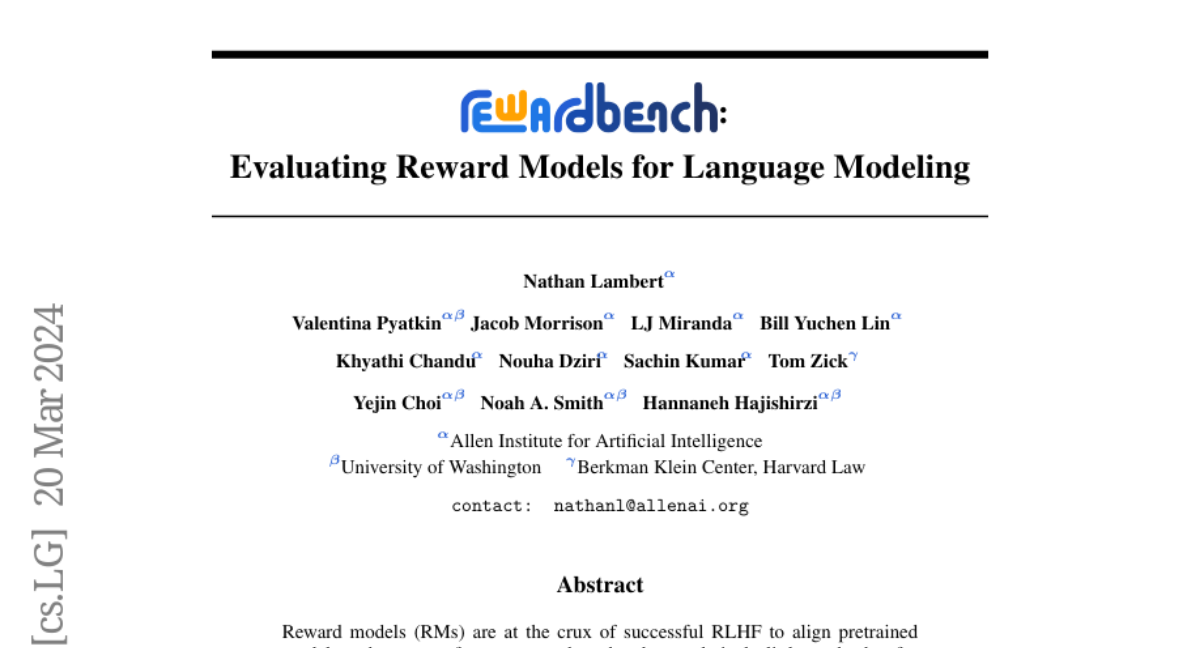
Reward models (RMs) are at the crux of successful RLHF to align pretrained models to human preferences, yet there has been relatively little study that focuses on evaluation of those reward models. Evaluating reward models presents an opportunity to understand the opaque technologies used for alignment of language models and which values are embedded in them. To date, very few descriptors of capabilities, training methods, or open-source reward models exist. In this paper, we present RewardBench, a benchmark dataset and code-base for evaluation, to enhance scientific understanding of reward models. The RewardBench dataset is a collection of prompt-win-lose trios spanning chat, reasoning, and safety, to benchmark how reward models perform on challenging, structured and out-of-distribution queries. We created specific comparison datasets for RMs that have subtle, but verifiable reasons (e.g. bugs, incorrect facts) why one answer should be preferred to another. On the RewardBench leaderboard, we evaluate reward models trained with a variety of methods, such as the direct MLE training of classifiers and the implicit reward modeling of Direct Preference Optimization (DPO), and on a spectrum of datasets. We present many findings on propensity for refusals, reasoning limitations, and instruction following shortcomings of various reward models towards a better understanding of the RLHF process.
IDAdapter: Learning Mixed Features for Tuning-Free Personalization of Text-to-Image Models
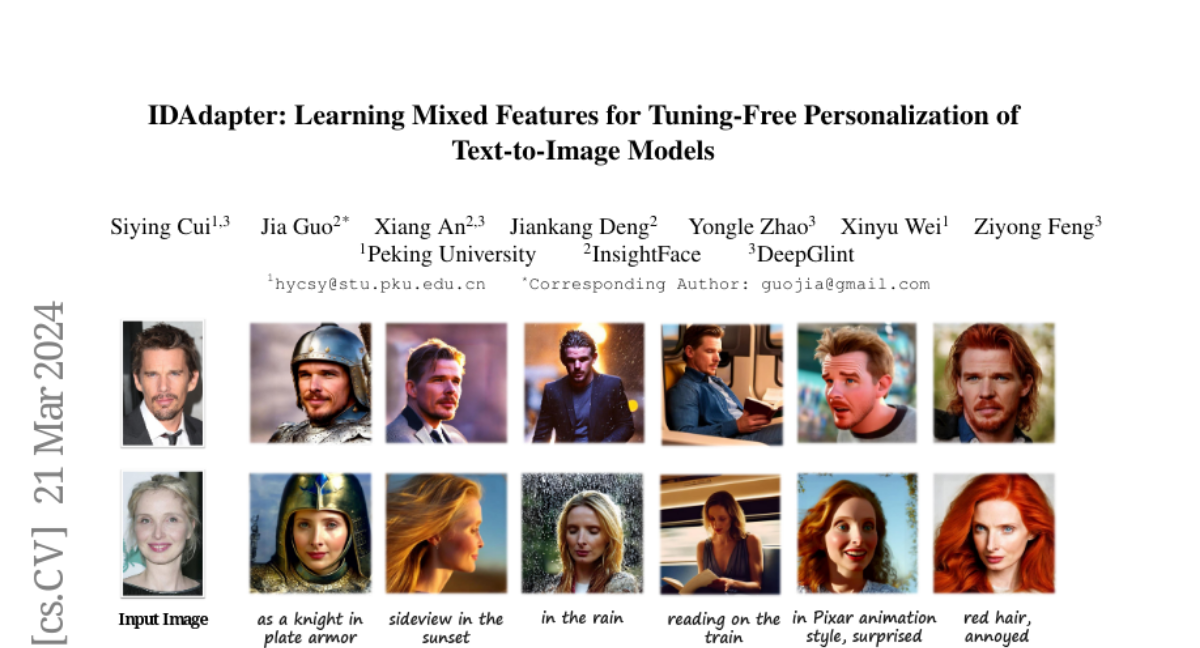
Leveraging Stable Diffusion for the generation of personalized portraits has emerged as a powerful and noteworthy tool, enabling users to create high-fidelity, custom character avatars based on their specific prompts. However, existing personalization methods face challenges, including test-time fine-tuning, the requirement of multiple input images, low preservation of identity, and limited diversity in generated outcomes. To overcome these challenges, we introduce IDAdapter, a tuning-free approach that enhances the diversity and identity preservation in personalized image generation from a single face image. IDAdapter integrates a personalized concept into the generation process through a combination of textual and visual injections and a face identity loss. During the training phase, we incorporate mixed features from multiple reference images of a specific identity to enrich identity-related content details, guiding the model to generate images with more diverse styles, expressions, and angles compared to previous works. Extensive evaluations demonstrate the effectiveness of our method, achieving both diversity and identity fidelity in generated images.
LlamaFactory: Unified Efficient Fine-Tuning of 100+ Language Models

Efficient fine-tuning is vital for adapting large language models (LLMs) to downstream tasks. However, it requires non-trivial efforts to implement these methods on different models. We present LlamaFactory, a unified framework that integrates a suite of cutting-edge efficient training methods. It allows users to flexibly customize the fine-tuning of 100+ LLMs without the need for coding through the built-in web UI LlamaBoard. We empirically validate the efficiency and effectiveness of our framework on language modeling and text generation tasks. It has been released at https://github.com/hiyouga/LLaMA-Factory and already received over 13,000 stars and 1,600 forks.
Compress3D: a Compressed Latent Space for 3D Generation from a Single Image
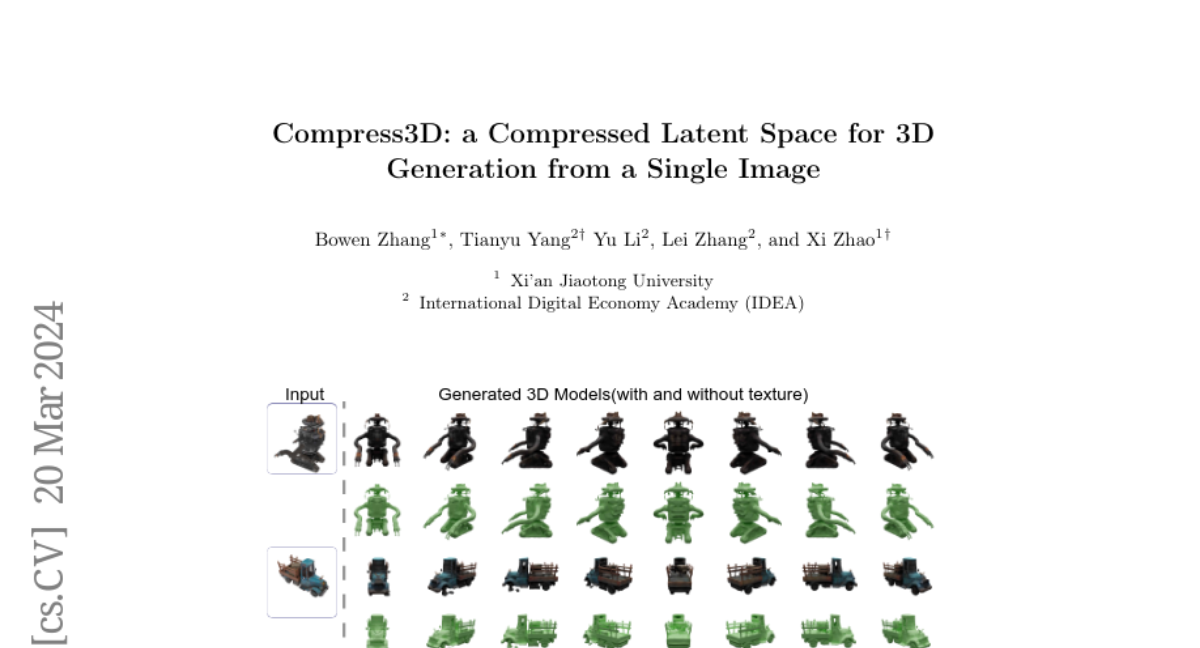
3D generation has witnessed significant advancements, yet efficiently producing high-quality 3D assets from a single image remains challenging. In this paper, we present a triplane autoencoder, which encodes 3D models into a compact triplane latent space to effectively compress both the 3D geometry and texture information. Within the autoencoder framework, we introduce a 3D-aware cross-attention mechanism, which utilizes low-resolution latent representations to query features from a high-resolution 3D feature volume, thereby enhancing the representation capacity of the latent space. Subsequently, we train a diffusion model on this refined latent space. In contrast to solely relying on image embedding for 3D generation, our proposed method advocates for the simultaneous utilization of both image embedding and shape embedding as conditions. Specifically, the shape embedding is estimated via a diffusion prior model conditioned on the image embedding. Through comprehensive experiments, we demonstrate that our method outperforms state-of-the-art algorithms, achieving superior performance while requiring less training data and time. Our approach enables the generation of high-quality 3D assets in merely 7 seconds on a single A100 GPU.
Evaluating Frontier Models for Dangerous Capabilities
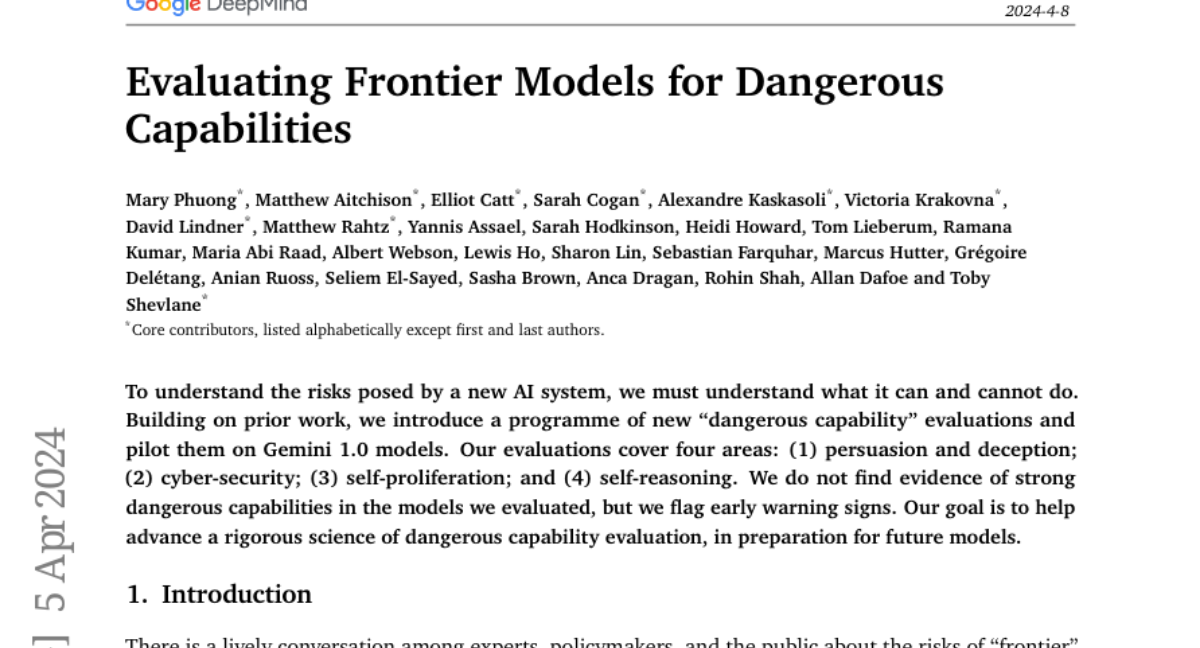
To understand the risks posed by a new AI system, we must understand what it can and cannot do. Building on prior work, we introduce a programme of new "dangerous capability" evaluations and pilot them on Gemini 1.0 models. Our evaluations cover four areas: (1) persuasion and deception; (2) cyber-security; (3) self-proliferation; and (4) self-reasoning. We do not find evidence of strong dangerous capabilities in the models we evaluated, but we flag early warning signs. Our goal is to help advance a rigorous science of dangerous capability evaluation, in preparation for future models.
Reverse Training to Nurse the Reversal Curse
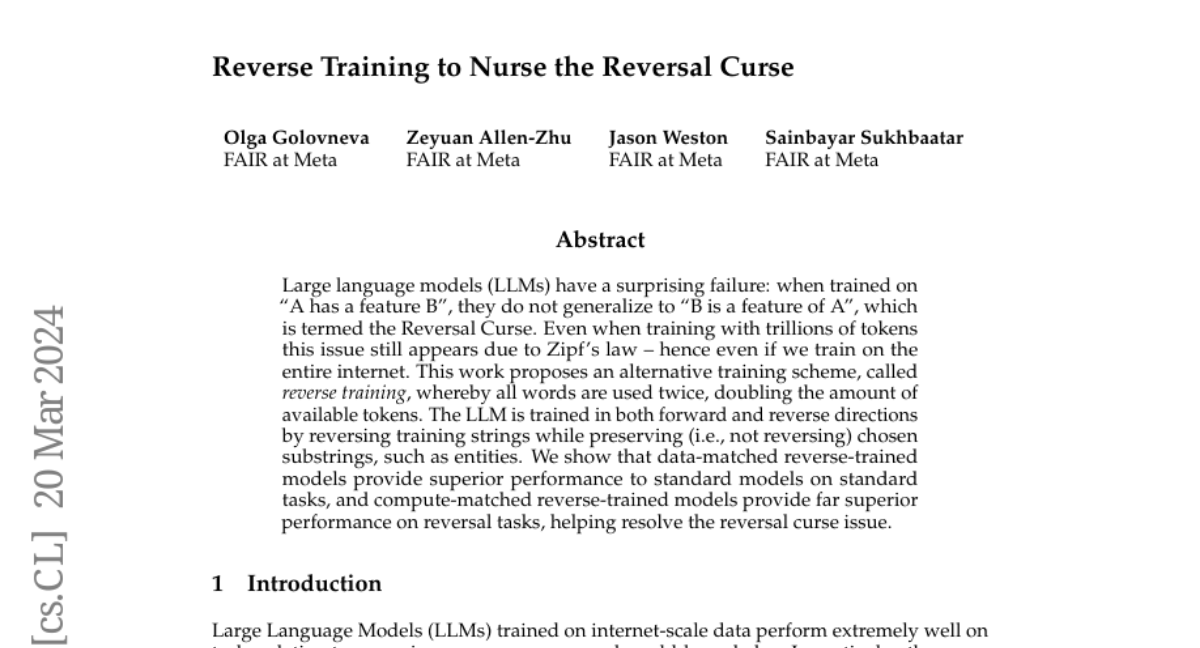
Large language models (LLMs) have a surprising failure: when trained on "A has a feature B", they do not generalize to "B is a feature of A", which is termed the Reversal Curse. Even when training with trillions of tokens this issue still appears due to Zipf's law - hence even if we train on the entire internet. This work proposes an alternative training scheme, called reverse training, whereby all words are used twice, doubling the amount of available tokens. The LLM is trained in both forward and reverse directions by reversing the training strings while preserving (i.e., not reversing) chosen substrings, such as entities. We show that data-matched reverse-trained models provide superior performance to standard models on standard tasks, and compute-matched reverse-trained models provide far superior performance on reversal tasks, helping resolve the reversal curse issue.
Be-Your-Outpainter: Mastering Video Outpainting through Input-Specific Adaptation

Video outpainting is a challenging task, aiming at generating video content outside the viewport of the input video while maintaining inter-frame and intra-frame consistency. Existing methods fall short in either generation quality or flexibility. We introduce MOTIA Mastering Video Outpainting Through Input-Specific Adaptation, a diffusion-based pipeline that leverages both the intrinsic data-specific patterns of the source video and the image/video generative prior for effective outpainting. MOTIA comprises two main phases: input-specific adaptation and pattern-aware outpainting. The input-specific adaptation phase involves conducting efficient and effective pseudo outpainting learning on the single-shot source video. This process encourages the model to identify and learn patterns within the source video, as well as bridging the gap between standard generative processes and outpainting. The subsequent phase, pattern-aware outpainting, is dedicated to the generalization of these learned patterns to generate outpainting outcomes. Additional strategies including spatial-aware insertion and noise travel are proposed to better leverage the diffusion model's generative prior and the acquired video patterns from source videos. Extensive evaluations underscore MOTIA's superiority, outperforming existing state-of-the-art methods in widely recognized benchmarks. Notably, these advancements are achieved without necessitating extensive, task-specific tuning.
RadSplat: Radiance Field-Informed Gaussian Splatting for Robust Real-Time Rendering with 900+ FPS

Recent advances in view synthesis and real-time rendering have achieved photorealistic quality at impressive rendering speeds. While Radiance Field-based methods achieve state-of-the-art quality in challenging scenarios such as in-the-wild captures and large-scale scenes, they often suffer from excessively high compute requirements linked to volumetric rendering. Gaussian Splatting-based methods, on the other hand, rely on rasterization and naturally achieve real-time rendering but suffer from brittle optimization heuristics that underperform on more challenging scenes. In this work, we present RadSplat, a lightweight method for robust real-time rendering of complex scenes. Our main contributions are threefold. First, we use radiance fields as a prior and supervision signal for optimizing point-based scene representations, leading to improved quality and more robust optimization. Next, we develop a novel pruning technique reducing the overall point count while maintaining high quality, leading to smaller and more compact scene representations with faster inference speeds. Finally, we propose a novel test-time filtering approach that further accelerates rendering and allows to scale to larger, house-sized scenes. We find that our method enables state-of-the-art synthesis of complex captures at 900+ FPS.
VSTAR: Generative Temporal Nursing for Longer Dynamic Video Synthesis

Despite tremendous progress in the field of text-to-video (T2V) synthesis, open-sourced T2V diffusion models struggle to generate longer videos with dynamically varying and evolving content. They tend to synthesize quasi-static videos, ignoring the necessary visual change-over-time implied in the text prompt. At the same time, scaling these models to enable longer, more dynamic video synthesis often remains computationally intractable. To address this challenge, we introduce the concept of Generative Temporal Nursing (GTN), where we aim to alter the generative process on the fly during inference to improve control over the temporal dynamics and enable generation of longer videos. We propose a method for GTN, dubbed VSTAR, which consists of two key ingredients: 1) Video Synopsis Prompting (VSP) - automatic generation of a video synopsis based on the original single prompt leveraging LLMs, which gives accurate textual guidance to different visual states of longer videos, and 2) Temporal Attention Regularization (TAR) - a regularization technique to refine the temporal attention units of the pre-trained T2V diffusion models, which enables control over the video dynamics. We experimentally showcase the superiority of the proposed approach in generating longer, visually appealing videos over existing open-sourced T2V models. We additionally analyze the temporal attention maps realized with and without VSTAR, demonstrating the importance of applying our method to mitigate neglect of the desired visual change over time.
Evolutionary Optimization of Model Merging Recipes

We present a novel application of evolutionary algorithms to automate the creation of powerful foundation models. While model merging has emerged as a promising approach for LLM development due to its cost-effectiveness, it currently relies on human intuition and domain knowledge, limiting its potential. Here, we propose an evolutionary approach that overcomes this limitation by automatically discovering effective combinations of diverse open-source models, harnessing their collective intelligence without requiring extensive additional training data or compute. Our approach operates in both parameter space and data flow space, allowing for optimization beyond just the weights of the individual models. This approach even facilitates cross-domain merging, generating models like a Japanese LLM with Math reasoning capabilities. Surprisingly, our Japanese Math LLM achieved state-of-the-art performance on a variety of established Japanese LLM benchmarks, even surpassing models with significantly more parameters, despite not being explicitly trained for such tasks. Furthermore, a culturally-aware Japanese VLM generated through our approach demonstrates its effectiveness in describing Japanese culture-specific content, outperforming previous Japanese VLMs. This work not only contributes new state-of-the-art models back to the open-source community, but also introduces a new paradigm for automated model composition, paving the way for exploring alternative, efficient approaches to foundation model development.
DepthFM: Fast Monocular Depth Estimation with Flow Matching
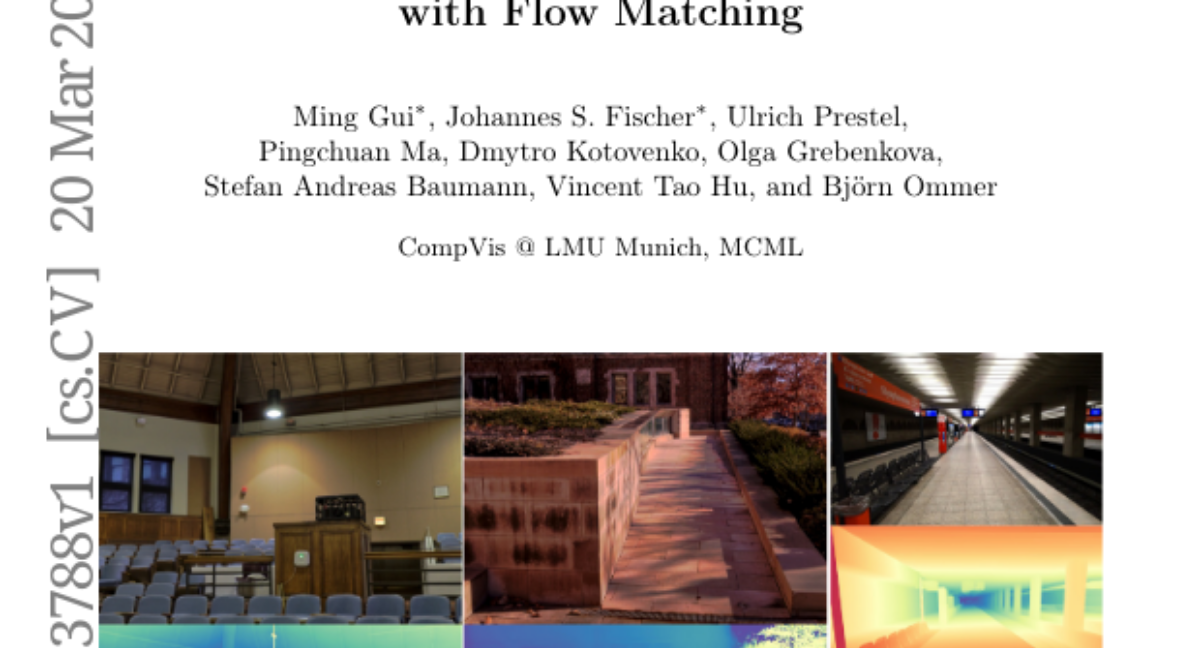
Monocular depth estimation is crucial for numerous downstream vision tasks and applications. Current discriminative approaches to this problem are limited due to blurry artifacts, while state-of-the-art generative methods suffer from slow sampling due to their SDE nature. Rather than starting from noise, we seek a direct mapping from input image to depth map. We observe that this can be effectively framed using flow matching, since its straight trajectories through solution space offer efficiency and high quality. Our study demonstrates that a pre-trained image diffusion model can serve as an adequate prior for a flow matching depth model, allowing efficient training on only synthetic data to generalize to real images. We find that an auxiliary surface normals loss further improves the depth estimates. Due to the generative nature of our approach, our model reliably predicts the confidence of its depth estimates. On standard benchmarks of complex natural scenes, our lightweight approach exhibits state-of-the-art performance at favorable low computational cost despite only being trained on little synthetic data.
ZigMa: Zigzag Mamba Diffusion Model

The diffusion model has long been plagued by scalability and quadratic complexity issues, especially within transformer-based structures. In this study, we aim to leverage the long sequence modeling capability of a State-Space Model called Mamba to extend its applicability to visual data generation. Firstly, we identify a critical oversight in most current Mamba-based vision methods, namely the lack of consideration for spatial continuity in the scan scheme of Mamba. Secondly, building upon this insight, we introduce a simple, plug-and-play, zero-parameter method named Zigzag Mamba, which outperforms Mamba-based baselines and demonstrates improved speed and memory utilization compared to transformer-based baselines. Lastly, we integrate Zigzag Mamba with the Stochastic Interpolant framework to investigate the scalability of the model on large-resolution visual datasets, such as FacesHQ $1024\times 1024$ and UCF101, MultiModal-CelebA-HQ, and MS COCO $256\times 256$. Code will be released at https://taohu.me/zigma/
HyperLLaVA: Dynamic Visual and Language Expert Tuning for Multimodal Large Language Models
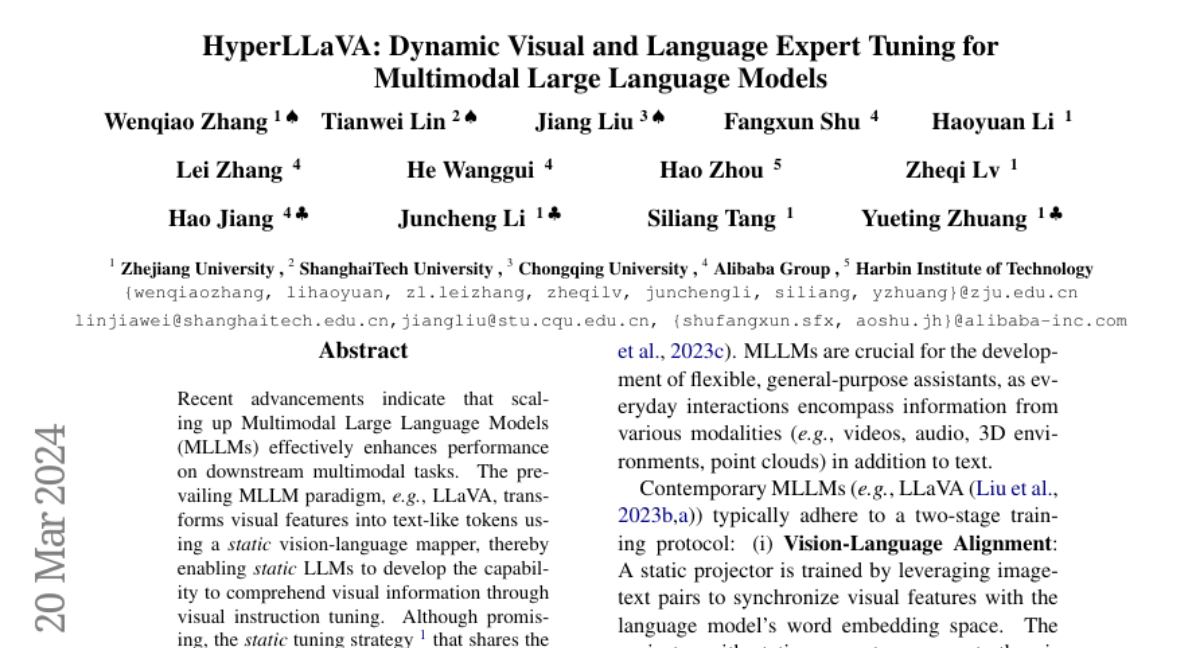
Recent advancements indicate that scaling up Multimodal Large Language Models (MLLMs) effectively enhances performance on downstream multimodal tasks. The prevailing MLLM paradigm, \emph{e.g.}, LLaVA, transforms visual features into text-like tokens using a \emph{static} vision-language mapper, thereby enabling \emph{static} LLMs to develop the capability to comprehend visual information through visual instruction tuning. Although promising, the \emph{static} tuning strategy~\footnote{The static tuning refers to the trained model with static parameters.} that shares the same parameters may constrain performance across different downstream multimodal tasks. In light of this, we introduce HyperLLaVA, which involves adaptive tuning of the projector and LLM parameters, in conjunction with a dynamic visual expert and language expert, respectively. These experts are derived from HyperNetworks, which generates adaptive parameter shifts through visual and language guidance, enabling dynamic projector and LLM modeling in two-stage training. Our experiments demonstrate that our solution significantly surpasses LLaVA on existing MLLM benchmarks, including MME, MMBench, SEED-Bench, and LLaVA-Bench. ~\footnote{Our project is available on the link https://github.com/DCDmllm/HyperLLaVA}.